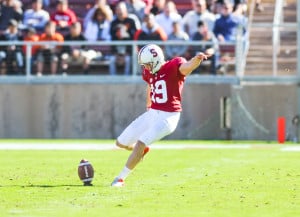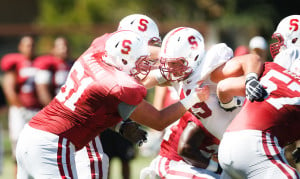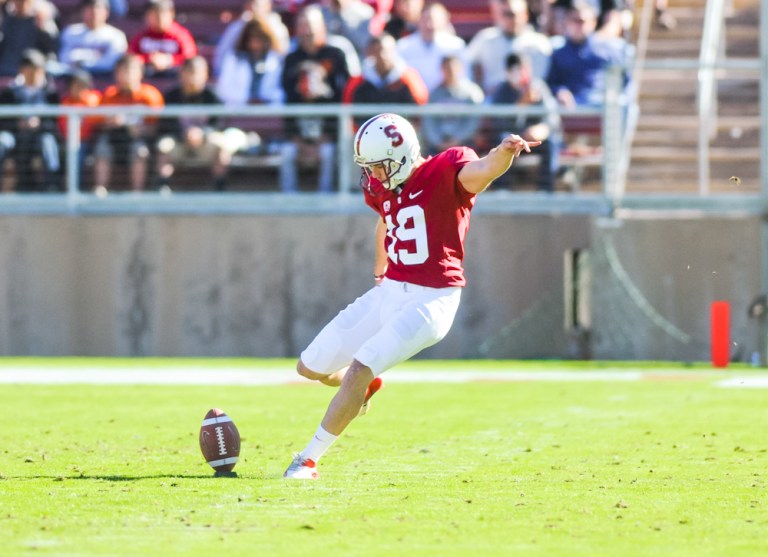Many people reached out to Cardinal kicker Jordan Williamson after his struggle in the 2012 Fiesta Bowl. Some were teammates and fellow Stanford students; others were family members and friends from high school.
One was a Fortune 500 CEO.
Cisco Chairman of the Board and CEO John Chambers, a college football fan, had seen Williamson miss that potential game-winning kick in Phoenix. But given the opportunity to meet Williamson, Chambers didn’t just want to reassure the then-sophomore. Chambers wanted to hire him.

“[He] wanted to kind of meet up and talk about my situation…and tell me how business is really, actually, pretty similar to sports,” Williamson said. “There’s ups and downs in both realms, and it’s just how you bounce back and how you learn from your failures, and come back and be stronger. And so he told me about some of the challenges that he faced both at Cisco and growing up, and we just kind of talked about how the two overlapped.”
That conversation led to Williamson’s internship at Cisco, where he has worked in sales and marketing for the last two summers. Williamson lived a busier life than most of his fellow interns, waking up for voluntary 6:30 a.m. team workouts before leaving for Cisco’s San Jose headquarters around 9 a.m. But for a Stanford football player, that’s just a typical summer day.
Williamson is one of the 70 to 80 Cardinal players who are employed every summer, working in fields from real estate and finance to medicine and biotech. In the six weeks between the end of spring quarter and the start of fall training camp, the players witness everything from boardroom deals to open-heart surgeries.
That’s a far cry from most other college football teams, nearly all of which use the summer as an opportunity for their players to catch up academically; the Cardinal’s director of football operations, Matt Doyle, claims that very few teams enroll fewer than 90 percent of their players in summer school. Though Stanford allows its players to take summer classes, Doyle said, only a handful of Cardinal football players have the need, and it’s usually due to course scheduling reasons, not academic issues. Still, that doesn’t mean the program is going to let the summer go to waste.
“We’ve taken something that might be perceived outside of this community as a disadvantage, and turned it into an advantage,” Doyle said. “We want our guys working. We want their résumés built up to a point that, when they graduate, they’ve got as good of a résumé as any college graduate in the country.”
It all starts with Doyle, who spends much of his time as the players’ de-facto headhunter. He coordinates the team’s 12th Man Summer Jobs Program, which connects interested employers specifically with Cardinal football players.
In return for their work, the players receive the money that many of them need to stay near campus for those voluntary summer workouts. The concept isn’t new, but the job descriptions have changed dramatically, especially over the past five or six years.
“You hear stories from some of the older players in the ‘60s and ‘70s talking about, ‘When I went to Stanford, I spent my summers lining the fields at Palo Alto High School,’” Doyle said. “Just doing stuff like that that paid, gave them some money in their pocket. But nowadays, we’ve got dozens of guys working in finance, in law, in tech, in startups, engineering firms.”
“There may be a startup company that just wants a hardworking, dedicated person that knows how to work in a dynamic team environment,” he added. “Well, that’s a Stanford football player who’s majoring in engineering.”
The summer jobs program is legal under NCAA rules, assuming that a few conditions — Doyle spells these out clearly to employers — are met. A player can’t be compensated unless he actually does work, can’t be paid more than his position is worth and can’t receive benefits that other interns do not. The player has to go through interviews like any other candidate and, of course, he must actually be qualified for the job.
Few players can draw a line between football and their summer internship as clearly as Williamson can, but just about all of them can thank the program to some degree. Once the football season is over, Doyle builds profiles of most of the players on the team, meeting with them to gauge their individual interests. He also works with them on their résumés, cover letters and interview skills — most members of the team even have LinkedIn pages — making up for the training that many players miss out on during the fall career fair rush, which overlaps with football season.
When it comes to actually pairing the players with a summer job, Doyle’s involvement varies. For some players, all Doyle has to do is communicate the compliance and timing considerations to their respective employers.
Take Stanford starting punter Ben Rhyne, a senior biomechanical engineering major, who approached one of his professors last year about working in the on-campus human performance lab. He ended up doing research there last summer, using EMG, 3D motion capture and other technology to model the movement of test subjects wearing heavy backpacks over long periods of time.
“[Before the summer,] I felt like I was a biomechanical engineer,” Rhyne said, “but I didn’t know what biomechanical engineers did.”
In other cases, a little push from Doyle is needed to set things in motion. Early in his career, senior running back Anthony Wilkerson found a summer position at Morgan Stanley with Doyle’s help. While there, Wilkerson made a connection that led to a position he earned on his own, an internship this summer at SHOOTMedia, a media consulting firm that specializes in sports.
“It’s setting us up for life,” Wilkerson said of the summer jobs program. “We’re not going to be playing this game for the rest of our lives, and we have a life after football.”
Oftentimes, Doyle is more involved in the process than the players even realize. When he was a freshman, senior center Conor McFadden set up a meeting with Jesse Rogers ‘79, the co-founder of the prominent Palo Alto firm Altamont Capital, to talk about private equity.
“When I got in, I was actually met by a couple of the vice presidents, who kind of grilled me on just random things,” McFadden remembered. “And I didn’t know a single answer. I just tried to keep a smile on my face, and just 20 minutes later, I’m sitting there, I’m like, ‘Wow, I’m the dumbest person ever.’ But Mr. Rogers came in and said, ‘Hey, would you like to work here this summer? People seem to enjoy being around you.’”
McFadden took the job, and went to go tell Doyle the news.
“I’m like, ‘Hey, this was a great experience,”’ McFadden said. “[Doyle] goes, ‘Yeah, I talked to Jeff actually, yesterday before you went in there, and I told him that you should look at this kid a little harder.’”
As with many of the employers in The 12th Man Summer Jobs Program, the Cardinal network runs deep at Altamont. Rogers serves on the board of Stanford University’s DAPER (Department of Athletics, Physical Education and Recreation) Investment Fund, and has hired several Cardinal football players over the years. Senior linebacker Blake Lueders also worked as an intern at Altamont last summer, which was McFadden’s third year with the company, and one of McFadden’s direct superiors was Chase Beeler ‘10 M.A. ‘11, his former Stanford teammate and fellow center.
The list of connections goes on. Another of McFadden’s former mentors on the offensive line, James McGillicuddy ‘09 M.A. ‘11, worked for two summers at investment banking firm ThinkEquity and two more at a different firm founded by Rogers, Golden Gate Capital, while part of the team.

“Because of my experience in finance working at Golden Gate Capital for two summers and ThinkEquity for two summers, I had a platform to speak somewhat intelligently and articulately [when I entered the workforce],” McGillicuddy said. “The exposure was unreal, to be honest with you. But then also them being cognizant about, ‘Hey, in the afternoon I have to go train for football.’…It was incredible.”
While many players’ non-football careers take flight in the 12th Man Program, it was actually McGillicuddy’s playing ability that got a big boost at ThinkEquity. McGillicuddy missed the first three years of his football career due to various injuries, including a lingering knee issue that threatened to keep him off the field through the end of college. But at ThinkEquity, McGillicuddy worked with former All-Pro quarterback Steve Bono, who had himself struggled with injury after retirement. Bono recommended the treatment that had healed his own Achilles tendon. McGillicuddy had the very same procedure done on his knee and he saw the first game action of his career that following season.
The Cardinal didn’t just get three good years out of McGillicuddy after that internship; it also planted the seeds for the continued growth of the summer jobs program. At McGillicuddy’s urging, the executives at RelateIQ, the startup where he now works, hired former Stanford walk-on Andrew Stutz ‘13 as an intern last summer. Stutz is no longer on the team, but he still works at RelateIQ part-time while pursuing a Master’s degree at Stanford.
Even if the employer’s affiliation is not that direct, many participants in the program have worked with a Stanford football intern in the past, were impressed by his performance and have become interested in hiring another Cardinal player as a result. According to Doyle, employers sometimes even ask an intern to recommend a Cardinal teammate. And so the network grows, year after year.
The team’s pipeline of summer jobs, as Doyle put it, takes many different forms. Internships can result from positive encounters with professors, alumni’s attempts to give back and, in one case, missed field goals. But the common thread is that Stanford football players are presented with unique opportunities off the football field, and that their support staff — chief among them, Doyle — is going to ensure they make the most of those chances.
“Coach [David Shaw] has often said, ‘Get everything you can out of Stanford. Wring it dry,’” Doyle said. “‘Be a sponge. Take advantage of what the campus offers, what your colleagues offer, what your fellow students offer, what the Stanford name offers.’”
Many of those who Doyle assists know what field they’re looking to work in; all he has to do is pull up a list of the employers who have reached out to him and talk to them to find the best fit for the player’s skillset. But 75 percent of the time, by Doyle’s estimation, his interaction with a player takes a different form — one that is even more valuable.
“[Sometimes] the guy walks in — smart guy, intelligent, hard-working — [and] has no idea what he wants to do,” Doyle said. “And he ends up working for a company that ends up changing his life.”
Contact Joseph Beyda at jbeyda ‘at’ stanford.edu.
